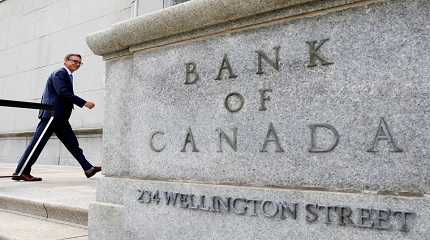
TORONTO, Aug 27 (Reuters) - Canada's second-quarter GDP report, due on Friday, is likely to show a sharp slowdown in economic growth, a Reuters poll of economists showed, which could lead the Bank of Canada to pause its interest rate hikes despite recent hotter inflation data.
The GDP report will be the last major piece of domestic data before the Canadian central bank makes its next policy decision on Sept. 6. It is expected to show the economy growing at a 1.1% pace in the second quarter, down from 3.1% in the first three months of the year, and below the BoC's 1.5% estimate.
That would be a relief to the market after the latest CPI report showed inflation rising above 3% in July, moving further away from the BoC's 2% target and raising expectations for another rate hike in September.
The BoC raised its benchmark rate to a 22-year high of 5% in July. The central bank has said it would study economic data closely before determining whether it raises interest rates further.
"We think this print is very important for the BoC's (September) decision," said Carlos Capistran, head of Canada and Mexico economics at Bank of America Merrill Lynch. "The BoC is in a data-dependent mode and has not closed the door to further hikes."
Some of the expected slowdown in the second quarter could be down to transitory factors, such as wildfires, maintenance on energy projects and a civil servants strike, which could mean that a preliminary estimate for July, due for release the same day as the quarterly data, will also be key for the rate outlook, say analysts.
"If there are clear signs the economy is slowing, that will likely give the BoC comfort it can hold the line at 5% for now and see more data," said Benjamin Reitzes, Canadian rates & macro strategist at BMO Capital Markets.
Money markets see a roughly 70% chance that the BoC will move to the sidelines in September but lean toward further tightening by the end of the year, which would result in interest rates peaking at 5.25% in the current cycle.
The July estimate follows recent preliminary data that showed a contraction in June activity and could be affected by a dock workers strike last month at ports along Canada's Pacific coast.
"Because we had that likely drop in GDP in June and then we've got the port strikes in July, there is a reasonable chance we get a negative GDP print for Q3," said Stephen Brown, deputy chief North America economist at Capital Economics.
The BoC has projected 1.5% growth for the third quarter, matching its second-quarter estimate.
Still, not every economist expects a pause. Some argue that the composition of growth in the second-quarter data, including the split between internal and external demand, could also be a consideration.
"If domestic demand still looks too strong, led by a rebound in housing and consumer spending on services, and the July figure points to a decent start to Q3, the Bank of Canada may still choose to continue hiking interest rates at the September meeting," said Andrew Grantham, a senior economist at CIBC Capital Markets.




